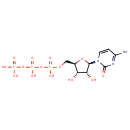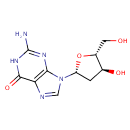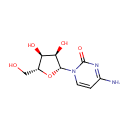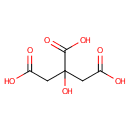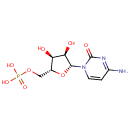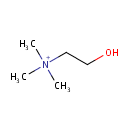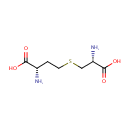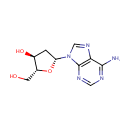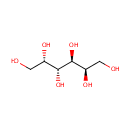
Search Results for compounds
Searching compounds for
returned 4373 results.
Cytidine triphosphate (PAMDB000030)
IUPAC:
({[({[(2R,3S,4R,5R)-5-(4-amino-2-oxo-1,2-dihydropyrimidin-1-yl)-3,4-dihydroxyoxolan-2-yl]methoxy}(hydroxy)phosphoryl)oxy](hydroxy)phosphoryl}oxy)phosphonic acid
CAS: 65-47-4
Description: Cytidine 5'-(tetrahydrogen triphosphate) or CTP is a cytosine nucleotide containing three phosphate groups esterified to a ribose moiety at the 5' position. CTP is integral to the synthesis or mRNA, rRNA and tRNA through RNA polymerases. Cytidine triphosphate (CTP) is also critical to the synthesis of phosphatidylcholine via the enzyme CTP: phosphocholine cytidyltransferase. This reaction is the rate-limiting step in the synthesis of phosphatidylcholine.
Deoxyguanosine (PAMDB000031)
IUPAC:
2-amino-9-[(2R,4S,5R)-4-hydroxy-5-(hydroxymethyl)oxolan-2-yl]-6,9-dihydro-1H-purin-6-one
CAS: 961-07-9
Description: Deoxyguanosine is a nucleoside consisting of the base guanine and the sugar deoxyribose. It is like guanosine, but with one oxygen atom removed. It is a nucleoside component of DNA. Deoxyguanosine can be converted to 8-hydroxy-deoxyguanosine (8-OHdG) due to hydroxyl radical attack at the C8 of guanine. 8-OHdG is a sensitive marker of the DNA damage This damage, if left unrepaired, has been proposed to contribute to mutagenicity and cancer promotion.
Glycerophosphocholine (PAMDB000032)
IUPAC:
[(2R)-2,3-dihydroxypropoxy][2-(trimethylazaniumyl)ethoxy]phosphinic acid
CAS: 28319-77-9
Description: Glycerophosphorylcholine (GPC) is a choline derivative and one of the two major forms of choline storage (along with phosphocholine) in the cytosol. Glycerophosphorylcholine is also osmolyte. GPC is an intermediate of glycerophospholipid metabolism. It is converted from both 2-acyl-sn-glycero-3-phosphocholine and 1-acyl-sn-glycero-3-phosphocholine by lysophospholipase L2 (EC:3.1.1.5). It is converted to choline and sn-glycerol 3-phosphate by glycerophosphodiester phosphodiesterase (EC:3.1.4.46). (KEGG)
Cytidine (PAMDB000033)
IUPAC:
4-amino-1-[(2R,3R,4S,5R)-3,4-dihydroxy-5-(hydroxymethyl)oxolan-2-yl]-1,2-dihydropyrimidin-2-one
CAS: 65-46-3
Description: Cytidine is a nucleoside that is composed of the base cytosine linked to the five-carbon sugar D-ribose. Cytidine is a pyrimidine that besides being incorporated into nucleic acids, can serve as substrate for the salvage pathway of pyrimidine nucleotide synthesis; as precursor of the cytidine triphosphate (CTP) needed in the phosphatidylcholine (PC) and phosphatidylethanolamine (PE) biosynthetic pathway. These variations probably reflect the species differences in cytidine deaminase. The biosynthesis of PC via the Kennedy pathway requires phosphocholine and cytidine triphosphate (CTP), a cytidine nucleotide, which is involved in the rate-limiting step. (PMID: 16769123, 15780864, 16720547)
Citric acid (PAMDB000034)
IUPAC:
2-hydroxypropane-1,2,3-tricarboxylic acid
CAS: 77-92-9
Description: Citric acid is key intermediate in metabolism. It is a key component of the citric acid or TCA (Krebs) cycle. Citric acid is first consumed and then regenerated by this sequence of reactions to complete the cycle. Bacteria use the TCA cycle to generate energy, but since they lack mitochondria, the reaction sequence is performed in the cytosol with the proton gradient for ATP production being across the plasma membrane rather than the inner membrane of the mitochondria.
Cytidine monophosphate (PAMDB000035)
IUPAC:
{[(2R,3S,4R,5R)-5-(4-amino-2-oxo-1,2-dihydropyrimidin-1-yl)-3,4-dihydroxyoxolan-2-yl]methoxy}phosphonic acid
CAS: 63-37-6
Description: Cytidine monophosphate, also known as 5'-cytidylic acid and abbreviated CMP, is a nucleotide that is found in RNA. It is an ester of phosphoric acid with the nucleoside cytidine. CMP consists of the phosphate group, the pentose sugar ribose, and the nucleobase cytosine.
Choline (PAMDB000036)
IUPAC:
(2-hydroxyethyl)trimethylazanium
CAS: 62-49-7
Description: Choline is a trimethylammonium compound. Choine can be used as a substrate by bacteria to generate osmoprotectants. Choline dehydrogenase (CHD) catalyzes the first step in the biosynthesis of the osmoprotectant glycine betaine from choline. CHD is associated with the membrane, is electron transfer-linked and oxygen dependent.
L-Cystathionine (PAMDB000038)
IUPAC:
(2S)-2-amino-4-{[(2R)-2-amino-2-carboxyethyl]sulfanyl}butanoic acid
CAS: 56-88-2
Description: Cystathionine is an intermediate in the synthesis of cysteine. It is generated from homocysteine and serine by cystathionine beta synthase. It is cleaved into cysteine and ketobutyrate by cystathionine gamma-lyase. (Wikipedia)
Deoxyadenosine (PAMDB000039)
IUPAC:
(2R,3S,5R)-5-(6-amino-9H-purin-9-yl)-2-(hydroxymethyl)oxolan-3-ol
CAS: 958-09-8
Description: Deoxyadenosine is a member of the chemical class known as Purine 2'-deoxyribonucleosides and Analogues. These are compounds consisting of a purine linked to a ribose which lacks an hydroxyl group at position 2. Deoxyadenosine is a deoxyribonucleoside. It is a derivative of the nucleoside adenosine, differing from the latter by the replacement of a hydroxyl group (-OH) by hydrogen (-H) at the 2' position of its ribose sugar moiety. Deoxyadenosine is the DNA nucleoside A, which pairs with deoxythymidine (T) in double-stranded DNA.
Galactitol (PAMDB000040)
IUPAC:
(2R,3S,4R,5S)-hexane-1,2,3,4,5,6-hexol
CAS: 608-66-2
Description: Galactitol, also called dulcitol, is a sugar alcohol, the reduction product of galactose. Galactitol is produced from galactose in a reaction catalyzed by aldose reductase. Galactose itself comes from the metabolism of the disaccharide lactose into glucose and galactose (Wikipedia). It appears as a white crystalline powder with a slight sweet taste.
